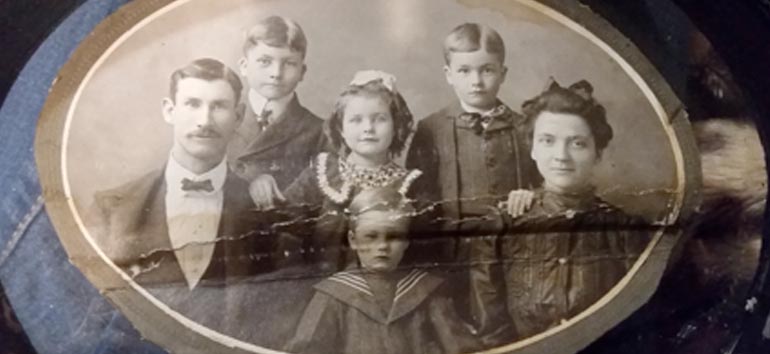Sign up for the Family Tree Newsletter Plus, you’ll receive our 10 Essential Genealogy Research Forms PDF as a special thank you!
Get Your Free Genealogy Forms
"*" indicates required fields
Identifying Twentieth-Century Photos
Denise Rothfus found this oval portrait in her neighbor’s garage. He thinks its Jesse James or Doc Holliday. Nope, Denise was right to question that identity. The picture dates from the first decade of the twentieth century. That’s a long time after Jesse’s death in 1882.
All the clothing clues add up to that 1900 to circa 1910 date. Mom’s hair bow, the sailor suit, and even the other boys’ suits are from the early twentieth century. You can find similar outfits in the Historic Catalogs of the Sears Robuck, and Co. on Ancestry.com.
That dark gray card stock was common in the early part of the century, too. Plus, look at the edges of the stock: there are ragged edges. This image looks like it’s been cut.
Before Photoshop®
Our ancestors had a wide variety of photo decisions to make when they went to the studio, and those can also be vital clues to the time the photo was taken.
- Image size
- Format
- Shape
- Coloring
- Framing
Photographs could be as small as a thumbnail (called a gem) or oversize, made for framing and hanging on the wall like a painting.
Not everyone chose a card photograph. In the early twentieth century, postcards were king. Cheap and easy to produce, studios offered clients the opportunity to take a photo suitable for mailing.
This family selected to cut their image an oval. However, it’s likely the original was a rectangle. There were also square images as well.
Handcoloring added to the cost of an image, but a lot of folks opted for a bit of pink for cheeks and gold jewelry. Full colored images resemble paintings. Crayon portraits transform the image to the look of a charcoal or paste sketch.
Some individuals opted to put their images on convex glass or on a tin frame that could sit on a bureau. Also, not all images came with an enclosure. Folded paper enclosures were quite common in the 1920s, but this image is different. It’s between two pieces of glass with a metal frame on the outside. Plus, it looks like it was intended for a different sized print.
Should it be kept in the frame?
I’m concerned that this image could deteriorate in the glass, but removing could cause even more damage. So far, it looks as crisp as the day the family left the studio.
The next time you look at an ancestral photo, think about why they selected that option. It could be significant.
FamilyTreeMagazine.com is a participant in the Amazon Services LLC Associates Program, an affiliate advertising program designed to provide a means for sites to earn advertising fees by advertising and linking to Amazon.com and affiliated websites.
ADVERTISEMENT





